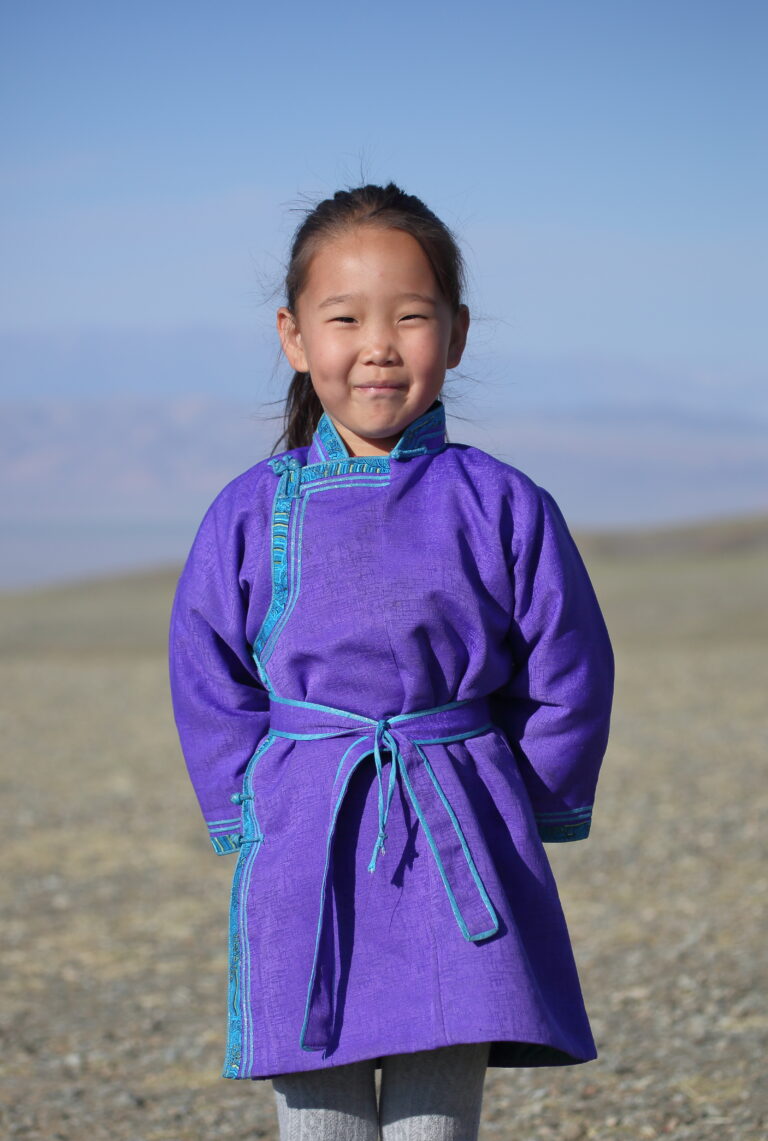
So here we are at long last in Ulaanbaatar, the capital of remote Mongolia, and yet even here beside the Tuul River, there are familiar birds like Goosander, Willow Tit and hundreds of Tree Sparrows, alongside exotics like Pacific Swift and White-crowned Penduline Tit, as well as a couple of ‘A list celebrities’, namely, the dashing Amur Falcon and the lovely Azure Tit. Not bad for an afternoon walk in the park.
With time to ‘kill’ this morning before a domestic flight, we visit another park en route to the airport where new birds include Booted Eagle, Black Stork, Green Sandpiper and Blyth’s Pipit.
Mongolia is so vast that after an internal flight we need to put the clocks back one hour on arrival in Ulgai, a frontier town in Mongolia’s ‘wild west’ where the local deity is Allah, rather than Buddha further east. With dozens of Black Kites swooping low over the houses, we also find Mongolian Gulls and a Masked Wagtail, looking like a Pied Wagtail wearing a black hood. Driving north through a seemingly endless treeless arid stony steppe grazed by an assortment of livestock including horses, cattle, goats, an unfamiliar breed of sheep and even yaks and camels, a brief roadside stop in the Buratt Pass at about 7500 feet produces close views of Rock Sparrow, White-winged Snowfinch and Raven as well as more distant views of Golden Eagle, Saker Falcon and large Tarbagan Marmots. Journey’s end is a rustic Ger camp not far from Khovd, capital of the local province. After dark a crescent moon rises, the milky way appears amid a myriad stars and an electrical storm flashes erratically above the distant lights of Khovd.
It’s calm and bright first thing this morning with Isabelline Wheatear and a cute little Pallas’s Pika for entertainment while waiting for our jeeps to arrive. After a slightly delayed start due to a mechanical problem with one of the jeeps, we arrive at the shore of the vast Khar-Us Lake where new birds come thick and fast including Isabelline Shrike, Ruddy Shelduck, Common and Demoiselle Cranes, Spoonbill, Black-winged Stilt, Pallas’s Gull and White-winged Tern. Along the shore we also find a Terek Sandpiper, and best of all, a Great Snipe, which is not even in the Birds of Mongolia fieldguide!
Moving on, we say goodbye to ‘civilisation’, turn off the tar road and head upwards on a white-knuckle ride, off road along dry riverbeds and up and down incredibly steep slopes, to our private Ger camp at around 6000 feet, with wide panoramic views of the Altai Mountains and close views of Mongolian Jirds (Gerbil-like creatures) and incredibly approachable Pallas’s Pikas. Just as we arrive, a posse of Black Kites chases off a passing Steppe Eagle, which rolls over in mid air to fend off the marauding kites with its outstretched talons.
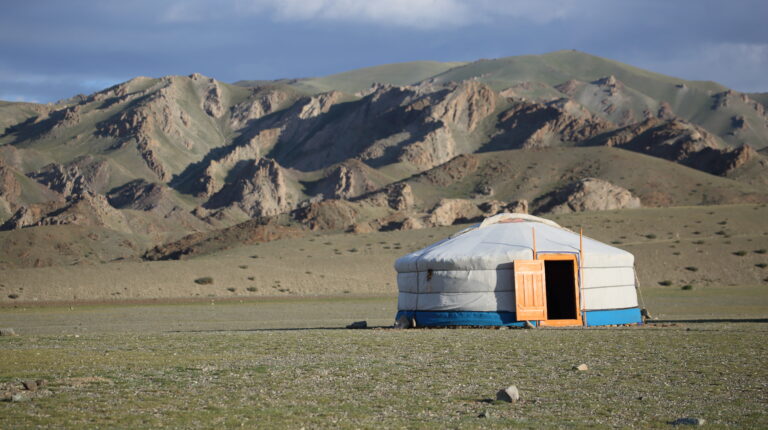
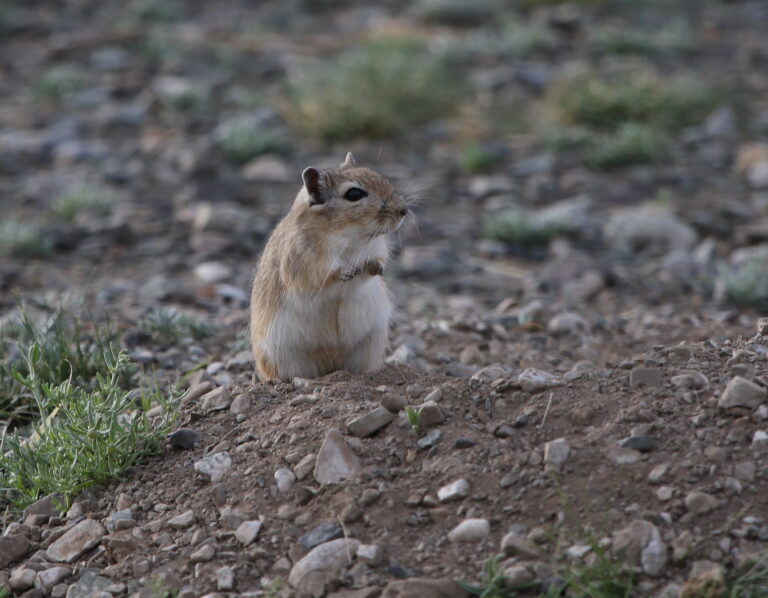
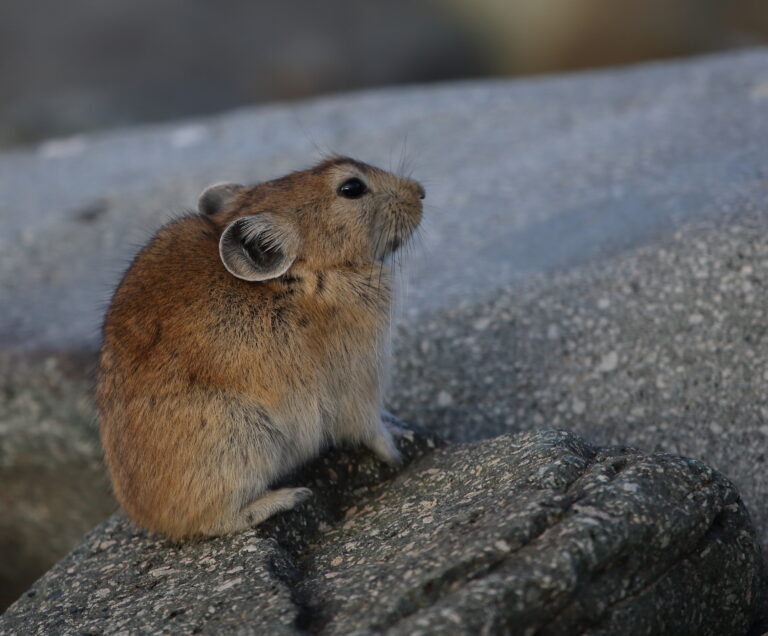
After lunch in the camp, we set off on a hike into a nearby steep sided valley, where the slopes are home to Crag Martins plus dozens of Hill Pigeons and Rock Sparrows. Further upstream, we also find Black Redstart, Brown Accentor, Twite and pink-flushed Mongolian Finches. The valley is also home to a pair of Bearded Vultures, and as one of the colossal adults flies in carrying a long bone, it’s chased off by a pair of Upland Buzzards. A juvenile Bearded Vulture then breaks cover from the rocky slopes and eventually the adult reappears to make several remarkable low-level circuits of the valley, right above us! What a fantastic day in an amazing place.
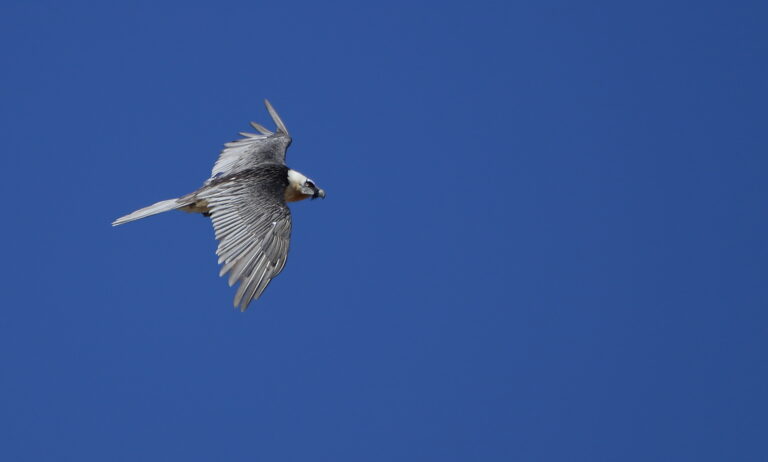
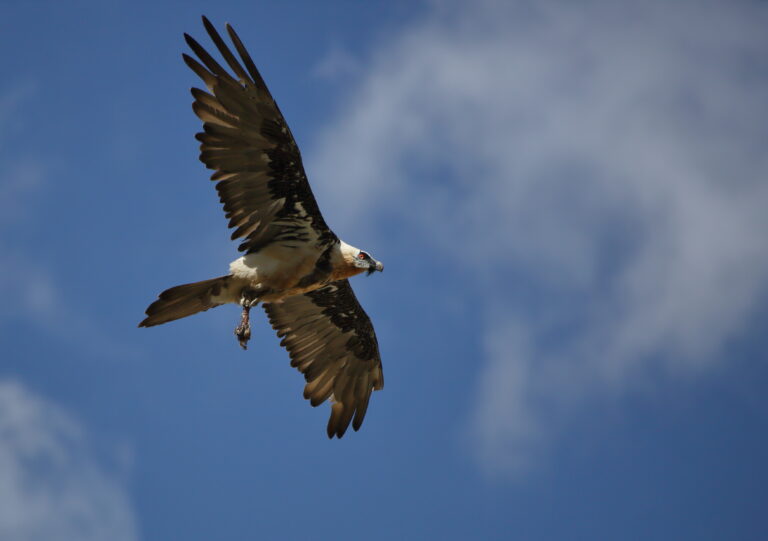
It’s bright and still first thing this morning, ideal for heading up into the mountains. Along the rocky off-road route we spot Tolai Hare and another Steppe Eagle before arriving in a canyon with rock art depicting ibex, deer and the figure of an archer, presumably created thousands of years ago! Further up the canyon, with slopes swathed by a purple haze of Veronica we find Water Pipit, Cinereous Vulture, Long-tailed Ground Squirrels and a herd of a dozen or so Siberian Ibex.
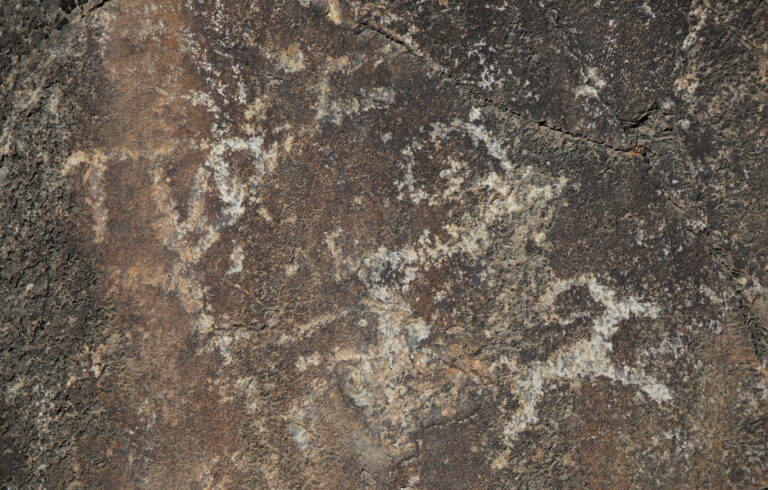
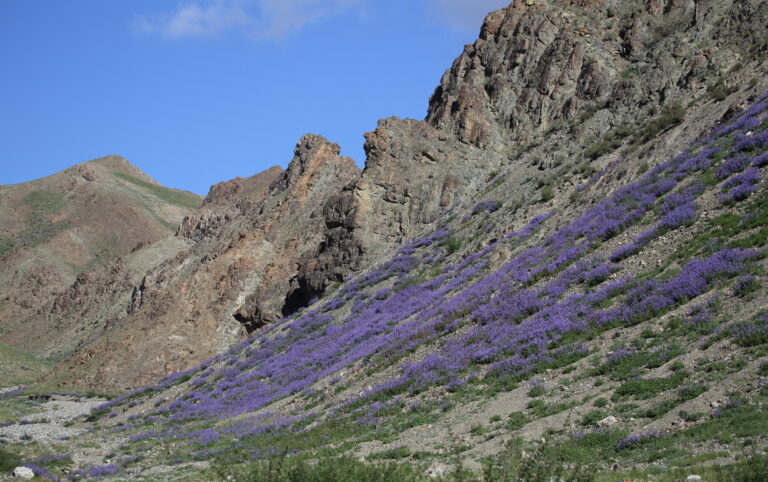
After an arduous two and a half hours for our skillful drivers, deftly negotiating rough rock-strewn dry stream bed crossings and scary precipitous slopes we arrive at the ‘end of the road’, on a rocky spur at around 10850 feet with a stunning 360 degree panorama across plunging valleys to rocky pinnacles and distant steppes.
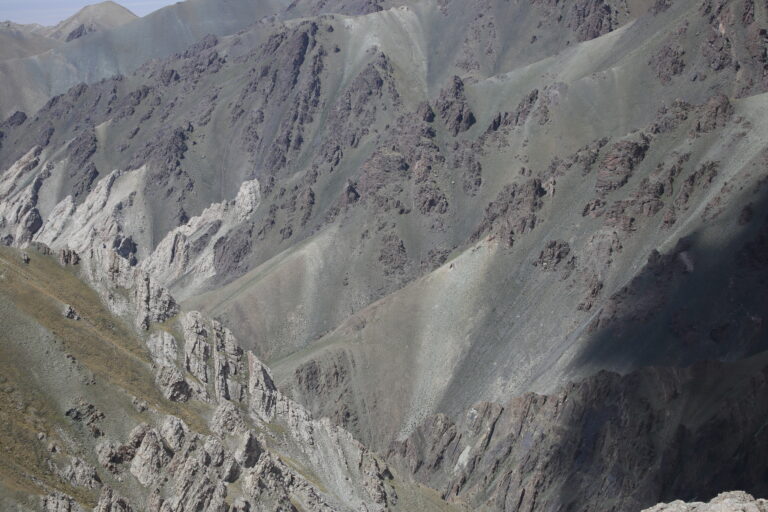
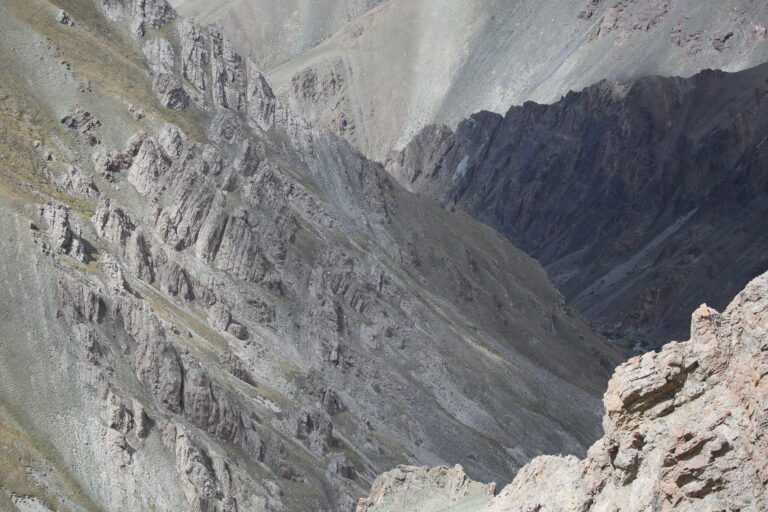
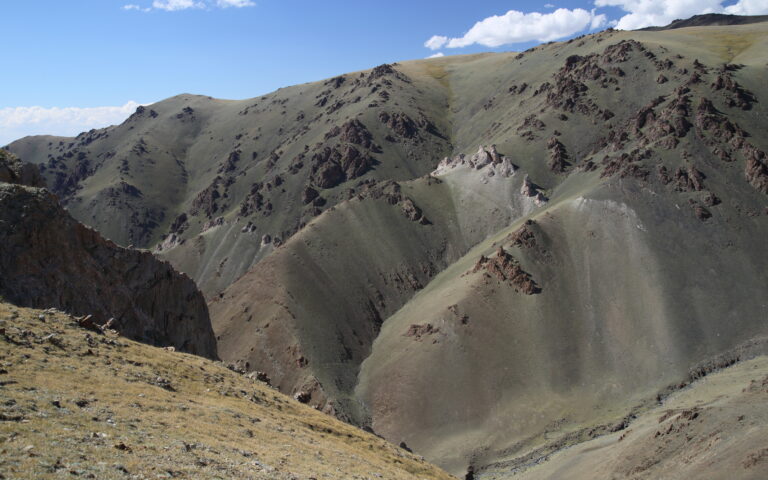
So, here we are in the ‘haystack’ where our search for the ‘needle’ begins! Early on we enjoy superb views of an adult Bearded Vulture looking out from its rocky ledge with starring red eyes, while a juvenile floats by along with a Cinereous Vulture. Once our picnic site is set up, we scan the many slopes from comfy folding chairs while Black Kites constantly swoop overhead hoping for scraps from our picnic table. Numerous Red-billed Choughs and White-winged Snowfinches flap around the cliffs, a Saker Falcon occasionally flies by, and we get great views of a male Güldenstädt’s Redstart, posing on the rocks right below our vantage point. This heavyweight redstart, a ‘lifer’ for me, is only found at these high altitudes and has an orange breast which matches the colour of the lichens splashed like paint on the rocks here.

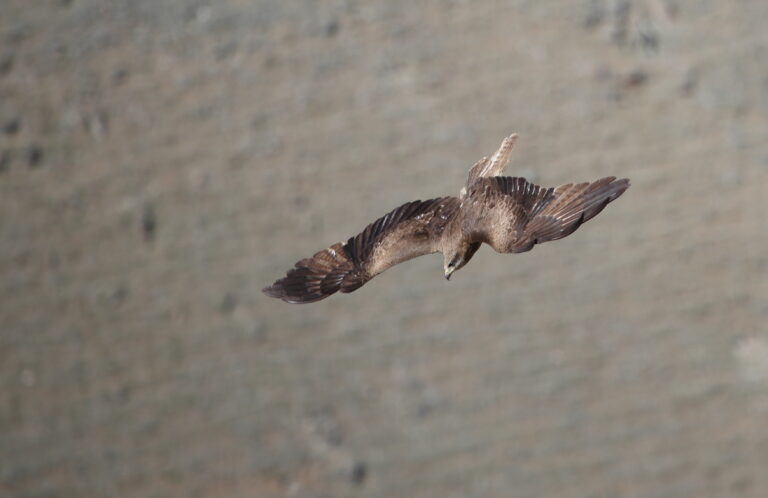


As the hours pass by and the sun moves westwards, the changing shadows add variety to the rugged landscape, while our search continues, supported by a team of scouts on horseback. By late afternoon our chief driver, who never usually walks anywhere, heads off with one of the scopes on foot to a new vantage point, suggesting that something is afoot. Our patient search continues, and then, around 6.30pm we are told to “get in the cars”! This is it, and after a short steep drive, we pile out and race down a slope, with the scopes, to a vantage point looking across the steep valley. After an initial panic, not being sure where we should be looking due to the obvious language barrier, we have found the ‘needle’! Miraculously, having travelled almost halfway across the globe to the ‘middle of nowhere’, we actually have an awesome Snow Leopard in our sights, as it slowly but purposefully strides along the far slope of the valley, on heavy paws, trailing a long sturdy up-curved banded tail with a black tip, and pausing at intervals for a good look around as if looking for a meal. Even at a distance of possibly half a mile, the charcoal markings dappling its thick ivory-coloured coat are clearly discernible! We watch this magnificent big cat for over 40 minutes until it lies imperiously on a rocky ledge and so we punch the air and head back to camp. Wow, what a remarkable achievement to have found the mythical ‘ghost cat’ in such an extensive wild landscape. Mission accomplished, after more than three years of planning!
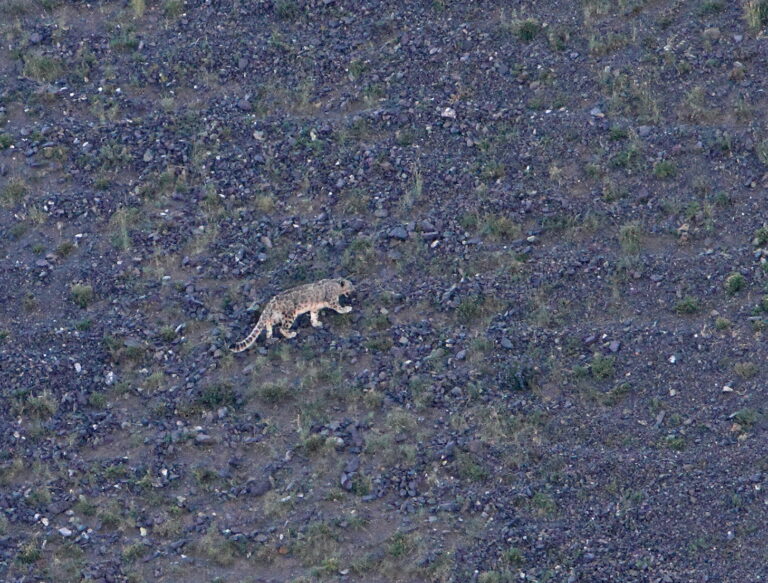
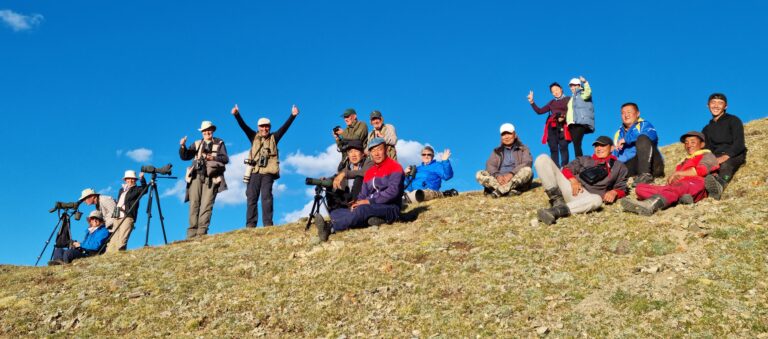
It’s another lovely morning as we set off ‘on safari’ in the jeeps, spotting a sandy Corsac Fox, plus Tolai Hare and then several Black-tailed Gazelles out on the vast rolling plain at the foot of ‘our’ mountains. Meanwhile, a stroll soon produces close views of a pair of Desert Wheatears and even closer views of some very large grasshoppers as well as the aptly named Toad-headed Agama, all on the menu for a nearby Steppe Grey Shrike and our main target bird here, the rare Henderson’s Ground Jay. Eventually we pinpoint a pair of these quirky birds, stalking the ground amid the sparse low scrub and occasionally overturning sizeable rocks with their stout decurved bills.
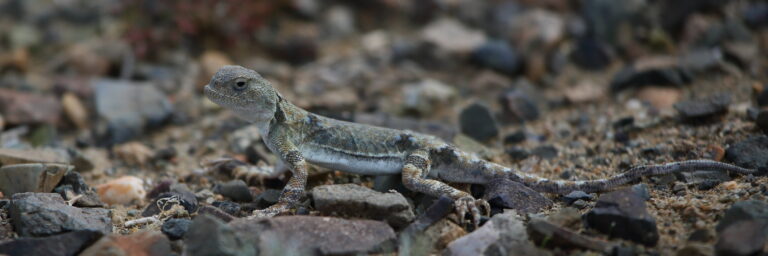
After lunch back at camp, we are entertained by a visiting local artist, playing a variety of local instruments, while also demonstrating the remarkable art of throat singing, which has to be seen to be believed.

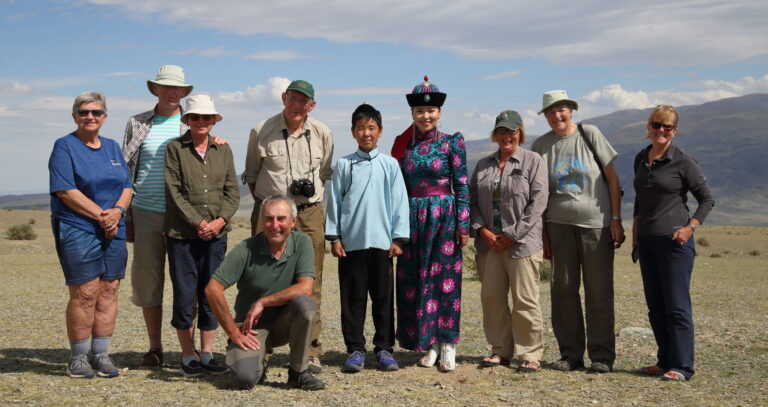
We spend the rest of the afternoon back in our local valley among camels and birds like Chukar, Crag Martin, Isabelline Shrike and Ortolan Bunting, with Saker, Upland Buzzard and Cinereous and Bearded Vultures up above. Where the stream from the mountains disappears into the dry riverbed heading to the plains, we watch a drinking session involving hundreds of Rock Sparrows plus Hill Pigeon, Horned Lark and Mongolian Finch.
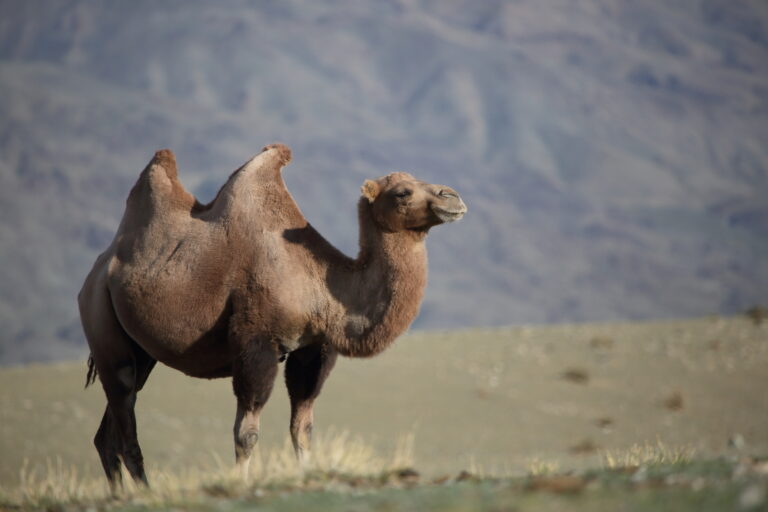
It’s another lovely sunny morning as we set off downhill in search of the Saiga Antelope which has a bizarre proboscis for a nose. Along the way we find another Tolai Hare and an all-chocolate brown adult Greater Spotted Eagle (only the juveniles have spots). Where the foothills meet the plains, a raptor fest includes Black Kite, Saker, Upland Buzzard, Steppe Eagle and a dozen or so Cinereous Vultures, one of which is seen off by the smaller eagle.
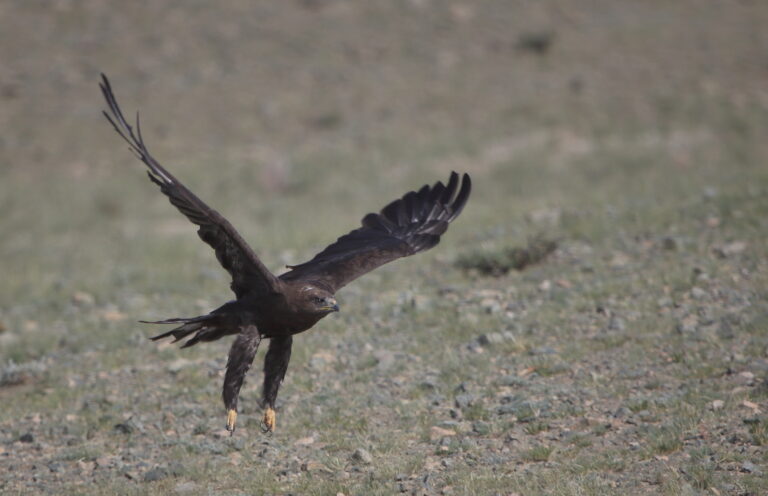
Once in the vast plain, sparsely covered with scant yellow vegetation we find Horned Larks and eventually our first Saiga, with a pronking calf, although the 28 degree heat haze makes the shimmering view rather surreal. As we drive for mile after mile, after mile, across the plain towards a shimmering blue lake, the ‘lake’ gets no closer as it’s just an illusion; a mirage, where more Saiga appear to be running on water! By midday we really have arrived at Durgon Lake, a vast inland ‘sea’ stretching for miles, with paddling ‘wild’ horses and a wealth of birdlife. While the cook prepares Spaghetti Bolognaise on a gas stove in the back of one of the jeeps, we add to our list with new birds like Caspian Tern (60 plus), a few Black Terns and a couple of Little Terns, as well as Whimbrel, Asian and Mongolian Short-toed Larks, Citrine and Yellow Wagtails and Pallas’s Reed Bunting.
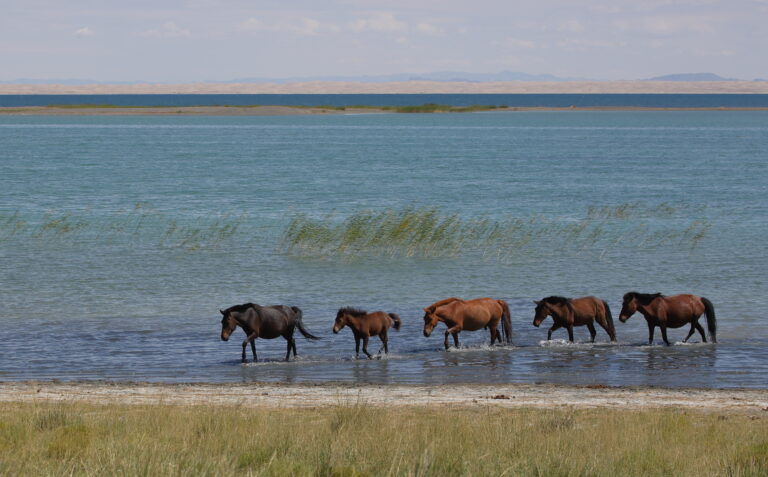
After lunch beside the lake, a stroll along the shore produces a wader fest including Kentish and Little Ringed Plovers, Pacific Golden Plover, Greater and Lesser Sand Plovers, Black-winged Stilt and Temminck’s Stint.
By late afternoon it’s time to drive back across the plain, where the heat haze has subsided, revealing far more Saiga, which virtually fly across the plain, leaving trails of dust in their wake, while capable of outrunning a jeep doing 45 miles per hour! What a remarkable animal.
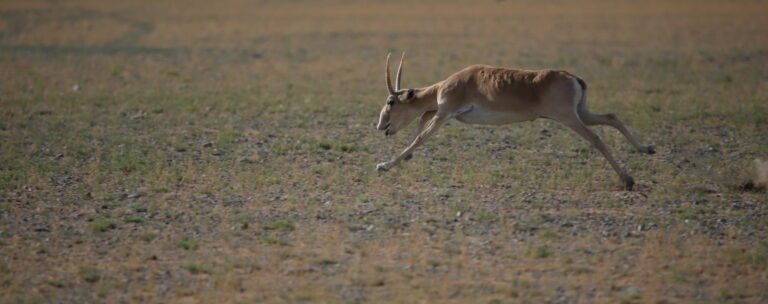
Henderson’s Ground Jay outside the camp toilets is not a bad start to any birding day in Mongolia! After breakfast we drive along dirt tracks to Chandmani, the nearest settlement, around 20 miles away. Along the way we find several Cinereous Vultures, a Steppe Eagle and a Greater Spotted Eagle, all perched in close proximity, as if they had been feeding on a carcass nearby.
In a birch grove not far from the town, amid dozens of whistling Black Kites, we find Spotted Flycatcher, Hoopoe, Hume’s Lesser Whitethroat and Green and Arctic Warblers, as well as another Greater Spotted Eagle, on the ground and refusing to budge even though we slowly approach to within 20 yards of it! As we retreat from the ‘great spot’, a pale morph Booted Eagle flies into a nearby birch with prey in its talons, close enough to show its starring amber eyes!
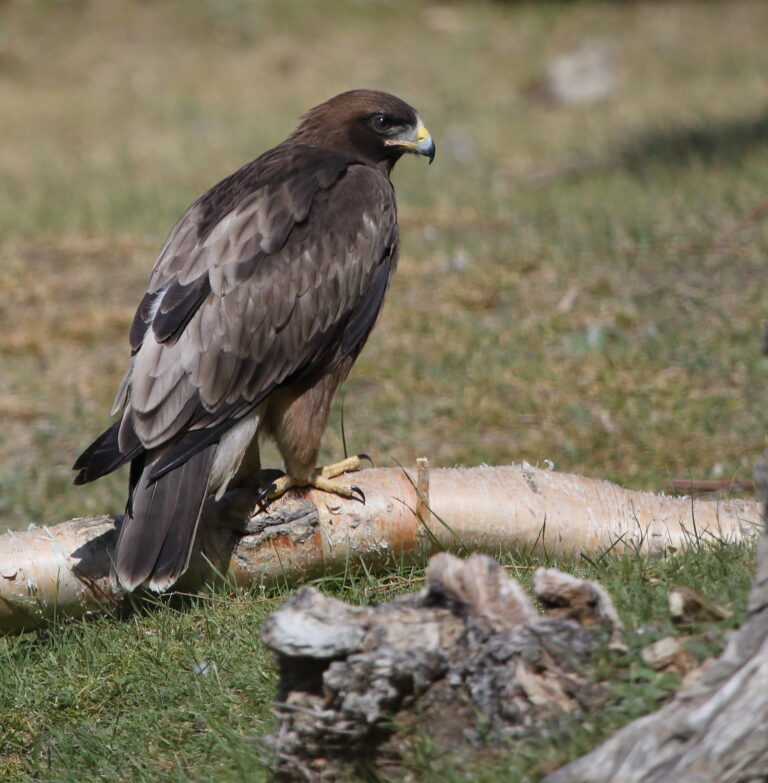
Moving on to the centre of town we find a few Pale Martins among all the Swallows, and a flock of Hill Pigeons, behaving just like town pigeons back home.
After lunch back in camp a local stroll produces more of the ‘usual suspects’ like Upland Buzzard, Cinereous and Bearded Vultures, Isabelline Wheatear and Shrike, Horned Lark, Crag Martin and Rock Sparrow.
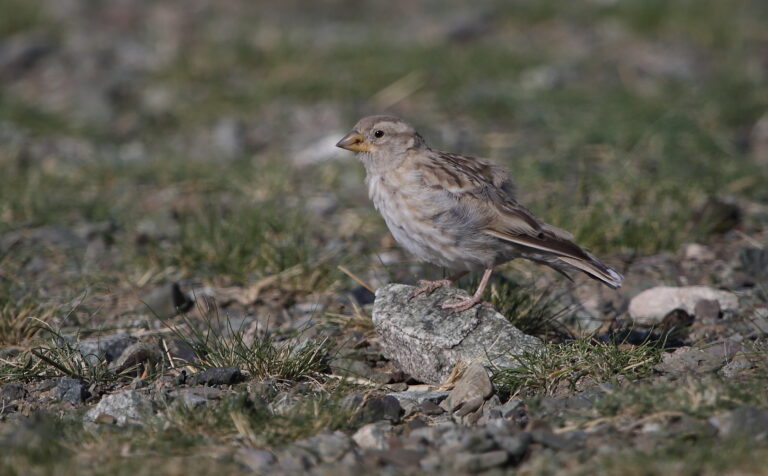
It’s time to leave camp for the last time this morning and drive to Khovd airport, off road! Along the way we pass several ground jays and Black-tailed Gazelles, as well as five more Saiga and then we ‘bump’ into a flock of Pallas’s Sandgrouse, sitting on the sandy track as we pass through a vast area of desert scrub. The first flock soon flies, but after a short search we find more, with some as close as just 20 yards, with dozens of others flying by.
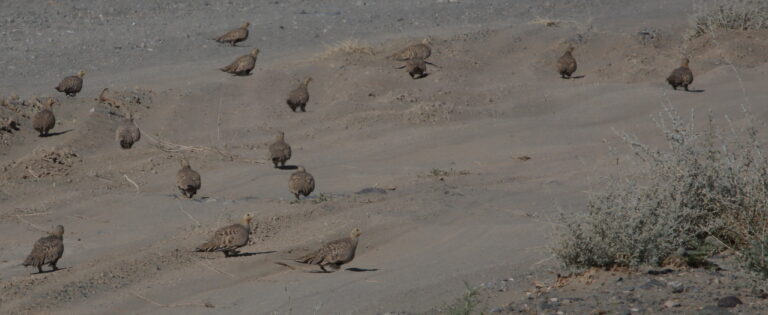
As the sand gives way to stones, stretching for miles across another vast expanse we find a Golden Eagle, down from the surrounding mountains to drink from a tiny trickle meandering across the dry stony plain. Minutes later we are in lush horticultural plots, owned by one of the drivers, who kindly slices and serves deliciously sweet watermelons straight from his field. After lunch in a restaurant in Khovd, it’s sadly time to say a big thank you and goodbye to our fantastic ground crew who worked so hard to show us all the amazing sights that we had experienced during our stay in this wonderfully wild region.
Having landed back in Ulaanbaatar, thanks to heavy traffic and road works, it takes longer to drive to the hotel than it did to fly halfway across this vast country! On the way back to the hotel, eating chicken and rice with chop sticks on a moving bus is a new challenge.
This morning we begin with another traffic jam on the way out of Ulaanbaatar and find Red-billed Choughs, Daurian Jackdaws and hundreds of Pacific Swifts on the edge of town. Further on, a stop overlooking the Tuul River, swollen by recent heavy rain, produces Demoiselle Crane and more Amur Falcons. The tar road soon runs out as we follow a bumpy dirt track for miles across rolling green hills, washed with pink splashes of Asters and wild garlic, towards an area called Manul Mountains, again in the ‘middle of nowhere’. Along the track we find plenty of Richard’s Pipits, more Pallas’s Reed Buntings and our first Mongolian Lark, a large lark with a wing pattern in flight like a Redshank.
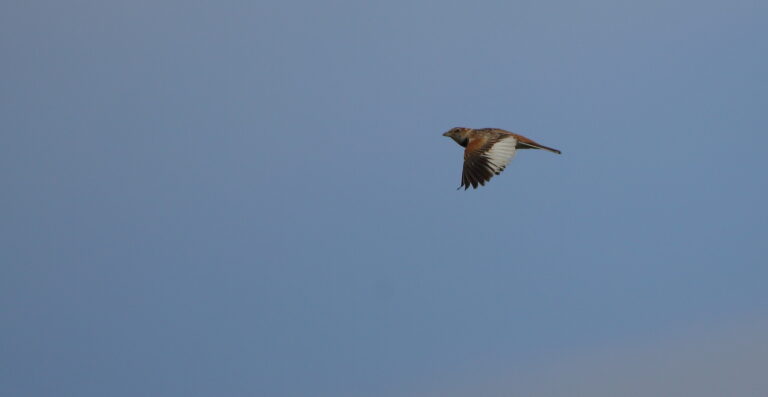
After lunch in our new Ger camp, our next outing produces sightings of a handful of Red Deer stags with impressive antlers, followed by about fifty Père David’s Snowfinches, feeding and preening on a rocky outcrop; another ‘lifer’ for me. Moving on to a higher rocky cliff, we find Rock Thrush, as well as Rock Sparrows and even Tree Sparrows, despite the absence of trees, with a Saker circling above.
As the afternoon sun begins to drop, we head for a viewpoint looking out across several rocky slopes, hoping to spot the elusive Pallas’s Cat, but after a couple of hours the only mammal sightings are a Corsac Fox, a marmot and some very busy Mongolian Mountain Voles.
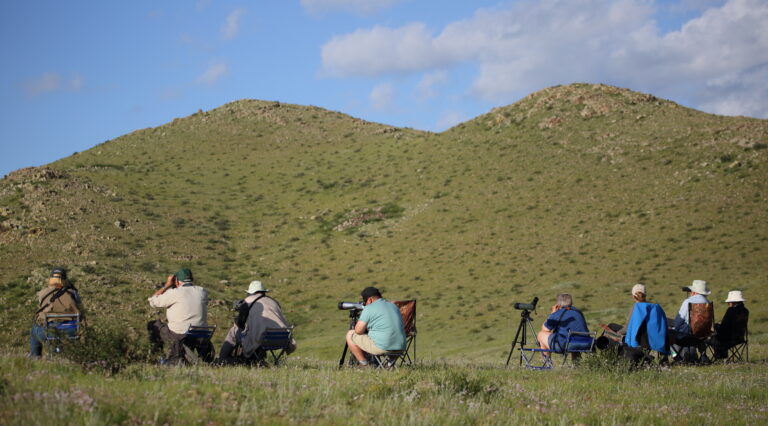
On previous days there has often been action around the toilets first thing and this morning is no exception, with a pair of Mongolian Mountain Voles actually building a nest inside the gents’ cubicle! After breakfast we return to the ‘cat scanning’ viewpoint, but after another hour, the only notable sightings are three marmots and a Little Owl, perched atop a large rock, and causing a kerfuffle amongst all the Isabelline Wheatears.
Next, we head ‘cross country’ through yet another vast wild landscape, with several fantastic vantage points, spotting another Corsac Fox, four Mongolian Gazelles and a herd of around thirty Red Deer, as well as Mongolian Larks, Steppe Eagles and Cinereous Vultures.
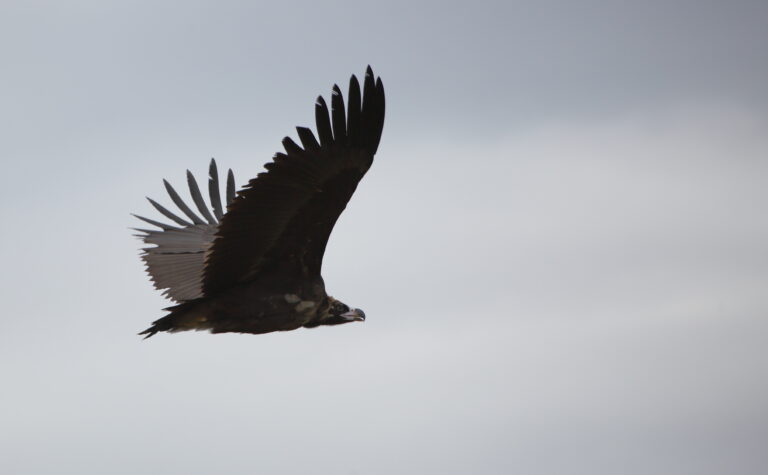
This afternoon, we drive to a different vantage point hoping to find Pallas’s Cat, but even with the aid of local knowledge from Gana, the ‘cat man’, who pioneered the tracking of Snow Leopards in Mongolia, seeing Pallas’s Cat proves to be a much harder challenge.
It’s our last day in the field and we head to Hustai National Park along yet another bumpy dirt track, bouncing along, sometimes at 50 miles per hour, thanks to our wannabee rally driver! On arrival we enter yet another vast wild landscape, this time dominated by impressive granite boulder outcrops, reminiscent of Dartmoor but on a much grander scale, with intense blue Fringed Gentians and plenty of raptors including Amur Falcon, Upland Buzzard, Steppe and Golden Eagles and another Bearded Vulture along with a group of at least 35 circling Cinereous Vultures. Meanwhile the mammals are represented by Corsac Fox, numerous Tarbagan Marmots and Red Deer, a herd of around 300 Mongolian Gazelles and a couple of dozen very rare handsome Przewalski’s Horses, which are a rich sandy colour above and white below, with neat black manes and matching black tails and ‘socks’.
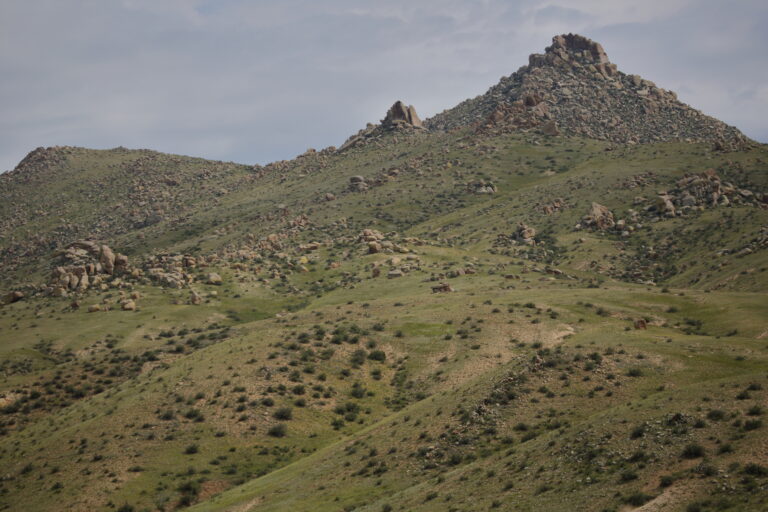
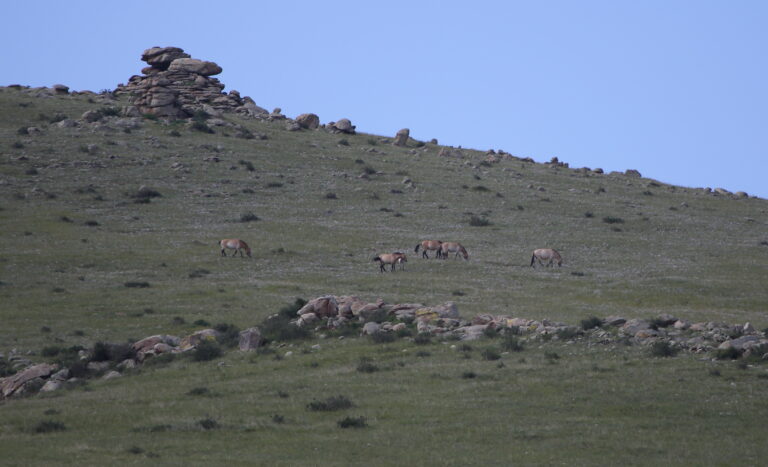
With so much spectacular wild scenery, glittering night skies, great people and wonderful wildlife, Mongolia is simply amazing. A big thank you and well done to all those involved in making this adventure so fantastic.
